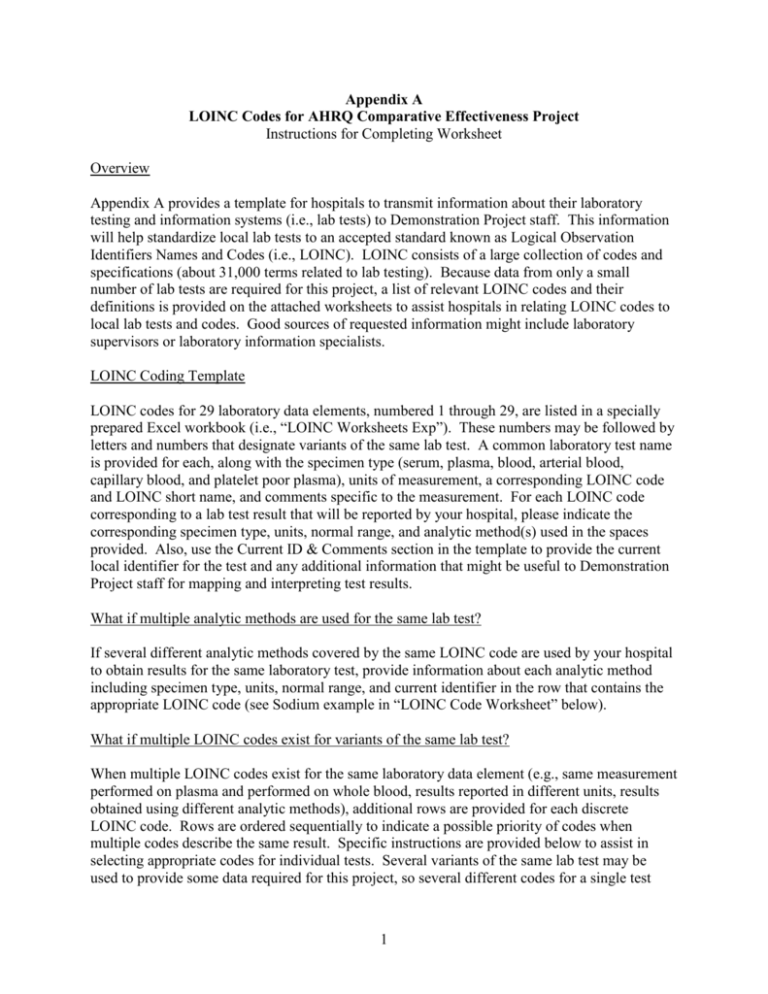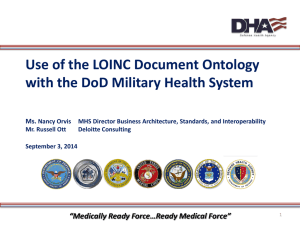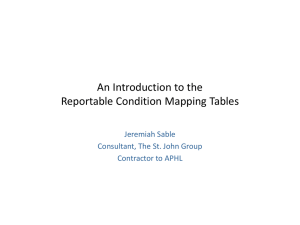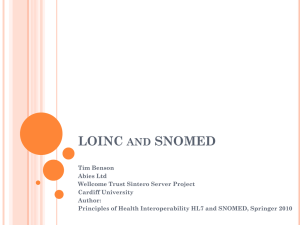Appendix A LOINC Codes for AHRQ Comparative Effectiveness
advertisement

Appendix A LOINC Codes for AHRQ Comparative Effectiveness Project Instructions for Completing Worksheet Overview Appendix A provides a template for hospitals to transmit information about their laboratory testing and information systems (i.e., lab tests) to Demonstration Project staff. This information will help standardize local lab tests to an accepted standard known as Logical Observation Identifiers Names and Codes (i.e., LOINC). LOINC consists of a large collection of codes and specifications (about 31,000 terms related to lab testing). Because data from only a small number of lab tests are required for this project, a list of relevant LOINC codes and their definitions is provided on the attached worksheets to assist hospitals in relating LOINC codes to local lab tests and codes. Good sources of requested information might include laboratory supervisors or laboratory information specialists. LOINC Coding Template LOINC codes for 29 laboratory data elements, numbered 1 through 29, are listed in a specially prepared Excel workbook (i.e., “LOINC Worksheets Exp”). These numbers may be followed by letters and numbers that designate variants of the same lab test. A common laboratory test name is provided for each, along with the specimen type (serum, plasma, blood, arterial blood, capillary blood, and platelet poor plasma), units of measurement, a corresponding LOINC code and LOINC short name, and comments specific to the measurement. For each LOINC code corresponding to a lab test result that will be reported by your hospital, please indicate the corresponding specimen type, units, normal range, and analytic method(s) used in the spaces provided. Also, use the Current ID & Comments section in the template to provide the current local identifier for the test and any additional information that might be useful to Demonstration Project staff for mapping and interpreting test results. What if multiple analytic methods are used for the same lab test? If several different analytic methods covered by the same LOINC code are used by your hospital to obtain results for the same laboratory test, provide information about each analytic method including specimen type, units, normal range, and current identifier in the row that contains the appropriate LOINC code (see Sodium example in “LOINC Code Worksheet” below). What if multiple LOINC codes exist for variants of the same lab test? When multiple LOINC codes exist for the same laboratory data element (e.g., same measurement performed on plasma and performed on whole blood, results reported in different units, results obtained using different analytic methods), additional rows are provided for each discrete LOINC code. Rows are ordered sequentially to indicate a possible priority of codes when multiple codes describe the same result. Specific instructions are provided below to assist in selecting appropriate codes for individual tests. Several variants of the same lab test may be used to provide some data required for this project, so several different codes for a single test 1 may be required to cover all these variants. In these cases, hospitals should complete rows for each variant for which a different LOINC code may be required. What if our hospital performs required lab tests that are not described by LOINC codes in the Template? Hospitals reporting required lab tests not described by LOINC codes in the attachment should describe these tests in the “To Be Completed by Hospital” section corresponding to the test number (n) followed by an X. If more than one line is required for a test, additional tests should be described on the supplementary worksheet entitled “Required Lab Tests Not Described by LOINC Codes in LOINC Code Worksheet,” numbering these entries nX1, nX2, etc. where n is the number assigned to the test being described. What if our hospital is already using LOINC codes? Hospitals already using LOINC codes for some or all of the required tests should complete the worksheets described above only for those tests for which LOINC codes are not currently being used. For all other required tests, LOINC codes currently being utilized should be recorded on the worksheet named “Currently-Used LOINC Codes” in the “LOINC Worksheets Exp” Excel workbook. Hospitals not currently utilizing LOINC codes should ignore this sheet. Validation of LOINC Codes by Demonstration Project Staff Demonstration Project staff will check LOINC codes against information provided by hospitals to confirm the accuracy of coding and will advise hospitals on how to code test variations not included in Appendix A or currently coded by hospitals. If possible, a copy of each relevant Laboratory Data Dictionary would assist Demonstration Project staff in completing this task. Comments on Individual Required Tests The following comments apply to individual tests: Base Units Deficit (Excess) – Either or both may be reported. Bicarbonate – Bicarbonate may be measured using different methods on different samples. All variations performed by a facility should be completed. 11. CK MB – This test is described by numerous LOINC codes depending on the sample analyzed, the measurement units, and the analytic method employed. Some possible combinations are not described by LOINC codes. If a facility reports CK MB determinations that do not correspond to listed codes, these determinations should be described as an 11X series. 13. Glucose – Serum/plasma samples have individual LOINC codes for a full range of random, fasting, and 2 hour post challenge measurements. Whole blood and capillary blood samples have codes only for some of these measurements. If a facility reports glucose determinations that do not correspond to listed codes, these determinations should be described as a 13X series. Other glucose measurements not covered by listed LOINC codes also should be described in this 13X series. 5. 6. 2 15. Inhaled oxygen concentration or flow rate – FIO2 and O2 Flow Rate are combined in item 15. When pO2 or O2 Saturation is reported, either FIO2 or O2 Flow Rate should be reported, if known. If neither is reported, an FIO2 of 20 percent will be assumed. 16. INR or prothrombin time – INR and Prothrombin Time are combined in item 16. If both results are reported on the same sample, both LOINC codes should be used with corresponding values. 18. Neutrophils band – Percent neutrophils is preferred measure. If number per volume is reported, corresponding total white blood count is required. When information is available, LOINC code should distinguish between manual and automated counts. 22. Platelet count – When information is available, LOINC code should distinguish between manual and automated platelet counts. 23. pO2 or O2 saturation – pO2 or O2 saturation are combined in item 23. If both determinations are performed at a facility, both LOINC codes should be used as appropriate. 29. White blood count – When information is available, LOINC code should distinguish between manual and automated white blood counts. Example of Completed Rows of a LOINC Code Worksheet The following are examples of completed rows of a LOINC Code Worksheet. Bolded entries are provided by the Demonstration Project. Italicized entries are to be provided by the hospital. LOINC Code Worksheet # Test Name Spec. Type Unit LOINC Code LOINC Name Comment 23A O2 Sat. Arterial Arterial Blood % 2708-6 O2 % BldA FIO2 if available 25 Sodium Serum / Plasma mEq/l = mmol/l 2951-2 Sodium SerPlsCnc 29B White Blood Count Whole Blood 10^9 cells/ul 6690-2 WBC # Bld Auto TO BE COMPLETED BY HOSPITAL Normal Unit Method Comment Range ABG11 Arterial Pulse % 94-100 FIO2 not Blood oximetry available Ion Serum mEq/l 135-145 exchangeNa1 gravimetric Flame Serum mmol/l 135-145 Na2 photometry Spec. Type Whole Blood 3 10^9 cells/ul 4.3-10.8 Flow cytometry WBC101









